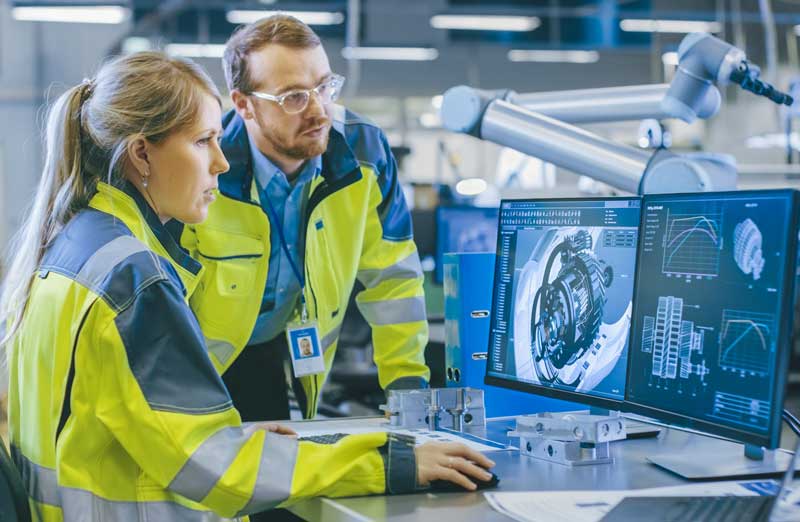Managed Services
Robotic Process Automation

Using digital technologies to automate processes helps increase efficiency. A clear example of this is in the deployment of Robotic Process Automation (RPA). Rather than the deployment of physical robots, this involves the use of software “bots” to automatically accomplish time-consuming data input tasks via UIs. The aim is to free up employees and give them time to carry out tasks that add more value.
What are the use case for robotic process automation?
To identify suitable areas for implementation of RPA, companies need to answer a simple question: “What processes do you employees find the most boring?” Generally, RPA technology is best suited to any processes that feature a high degree of repetitive, manual, rules-based activities, with as few as possible, clearly defined deviations from standards. Such tasks include completion of forms, filing and moving documents or other administrative activities. Some areas in which RPA is used very effectively include:

IT systems management
Robotic process automation allows substantive and time-intensive procedures such as user and transport management in ERP systems, creation of system copies and extensive master data management to be accomplished quickly and reliably. As a result, IT teams can focus more strongly on the tasks that generate value for the business.
Finance and bookkeeping
Automatically generated reports on transactions, invoices and budgets help save time and improve transparency. In particular in conjunction with quarterly reporting and month-end procedures, they are a valuable and simple tool that gives employees time to focus on value-generating roles.
Human resources
From automated timekeeping to employee self-service systems for completing forms and fully automated onboarding processes, RPA improves the efficiency of individual workflows and makes life easier for workers.
What are the benefits of RPA?
In addition to accomplishing time-intensive processes, the main advantages of robotic process automation are predominantly technological:

Rapid implementation
RPA software is relatively easy to program, usually through a low-code platform. That means that it can be deployed very quickly and efficiency benefits can be obtained almost immediately.

Simple scalability
Once the standard processes have been implemented, automated workflows can be scaled and expanded at the touch of a button.

No back-end interventions
RPA code imitates human interactions with the UI, so there is no need for interfaces to gain access to the underlying systems.

Reliability
Software bots do not make careless mistakes. Once the RPA software has been coded to determine how, when and how frequently an action should be carried out, it will continue to do so reliably and without making any errors.

Availability
Robotic process automation carries on working through public holidays, regional holidays and vacations. These automated workflows are executed around the clock, 365 days a year.
What are the challenges of RPA?
The ease of technical implementation of robotic process automation means that the challenges are less in realising the system and more in preparatory activities, especially when it comes to connecting up to the Industrial Internet of Things (IIoT). Users need to understand their processes in minute detail to exploit the maximum potential of RPA here and in all other areas of the business. Project managers will need to find answers to the following questions:
Do I have a complete, gap-free overview of all of the relevant business processes?
Processes can only be improved if the operators understand all of their features and characteristics. Therefore, every RPA project starts with a comprehensive analysis and evaluation of the status quo. In particular, the opportunity to speak to external service providers and partners who shed fresh light on matters often reveals innovative and useful ideas.
What are the best RPA solutions for my requirements?
From Microsoft Power Automate to SAP IRPA, the range of RPA solutions is large, but not all are equally suited to all tasks. An experienced IT service provider will be have the necessary expertise to provide an overview and support.
How do I organise service, support and development for my RPA landscape?
If a process goes down or users request minor adjustments, it is necessary to clarify who will take care of the work. This could be specialists in your own IT department who have the necessary expertise, or an external service provider that offers Application Management Services for RPA. The advantage of entrusting the activity to a strong partner is that you give your internal team greater freedom to continue expansion of the RPA landscape.

Robotic Process Automation – examples
The automation of processes to deal with repetitive and time-consuming activities is suitable for many areas of the business. Here are two examples of how robotic process automation can be deployed:
ERP system monitoring and updates
If companies fail to check critical transactions in their ERP systems on a daily basis, they risk damaging, bad decision-making on the basis of incorrect or insufficient information. However, a manual check of all error messages and interrupted jobs each day has high financial and time implications. RPA software can carry out this task automatically, quickly and reliably, around the clock, every day of the week.
Licence management
Ensuring transparency of all of the software licences used in the company is not only about compliance, it is also a matter of security. Companies that use RPA services to automate their joiner-mover-leaver (JML) process can save time and reduce the opportunity for human error that may have serious legal and financial consequences.
Application Management Services for RPA
The progress of RPA in many businesses currently is resulting in increased demand for service and support. The robots themselves are generally very stable and rarely susceptible to faults, however it is vital that the businesses are able to respond to incidents and be ready for change and service requests so that they can react quickly and professionally when necessary.
We are supporting this through a combination of our proven AMS experience and our RPA expertise. Application Management Services (AMS) for RPA provide businesses with service and support precisely in line with the level of service they need. This means defined response times, professional ticket handling, backed up by the latest knowledge of proven RPA experts. Freed up from this responsibility, the businesses’ staff can focus on strategic development of their RPA solutions.
Our offering includes:
- Application support in accordance with professional IT service management standards
- Fast response times, defined SLAs and efficient service models
- System monitoring and healthchecks
- Incident management and service request management
- Short-notice system adaptations
- Consulting and implementation support for expansion of the RPA landscape
Why should Syntax be the first port of call for Robotic Process Automation?
IRPA or Power Automate – the success of robotic process automation is not simply about which solution to choose or how it is implemented. At the start of any RPA project it is necessary to examine the key business processes in detail. These workflows and sector-specific requirements must be understood precisely in order to support companies as a strong partner and help tap into the full potential of robotised solutions, for example as part of a digital factory. At Syntax we have accumulated this expertise over many years and in countless projects with companies of different sizes and in different industries. We work together with the business departments and IT teams to identify, design and implement custom RPA services. Whether the aim is to introduce completely new processes, improve existing workflows, monitor processes that have already been automated or update an existing RPA solution, we understand the advantages of the technology and can get the most out of its benefits.

FAQ: RPA in simple terms
What is Robotic Process Automation?
Robotic Process Automation (RPA) has nothing to do with physical robots. The technology is concerned with the use of automated software “bots” that replicate the actions and commands of human users via the UI of a system. These interactions are primarily manual, time-consuming and repetitive tasks such as completing forms or filing documents. RPA systems are normally programmed using a low-code or even no-code approach, and ensure that employees have more time for creative tasks that add value to the business. Since the logic behind these processes is relatively simple to replicate, the ease of implementation and scalability of RPA are key benefits.
What is the difference between RPA and regular automation?
The main difference between RPA and (standard) automation is that RPA is non-invasive. This means that the RPA bot software only ever interacts with the existing user interface (UI) and no interfaces to the underlying software system are required in order to automate the actions. This avoids time and money-consuming changes to the existing IT infrastructure. As far as the system is concerned, each “bot” is the same as a human user. This differentiates RPA from traditional approaches to automation which generally involve modification of parallel systems so that their processes can interact smoothly.
What is the difference between RPA and artificial intelligence?
The bots in an RPA solution can be envisaged like a hand, carrying out the given process automatically and reliably, without errors. However, once the process strays from a specific standard or if unforeseen errors occur, the bot terminates its action. Artificial intelligence uses algorithms to learn from the processing of large volumes of data over time and work out its own solutions when needed. Therefore, AI is the brain that can tell the hand what to do in cases where it needs to respond to variations from the standard process.